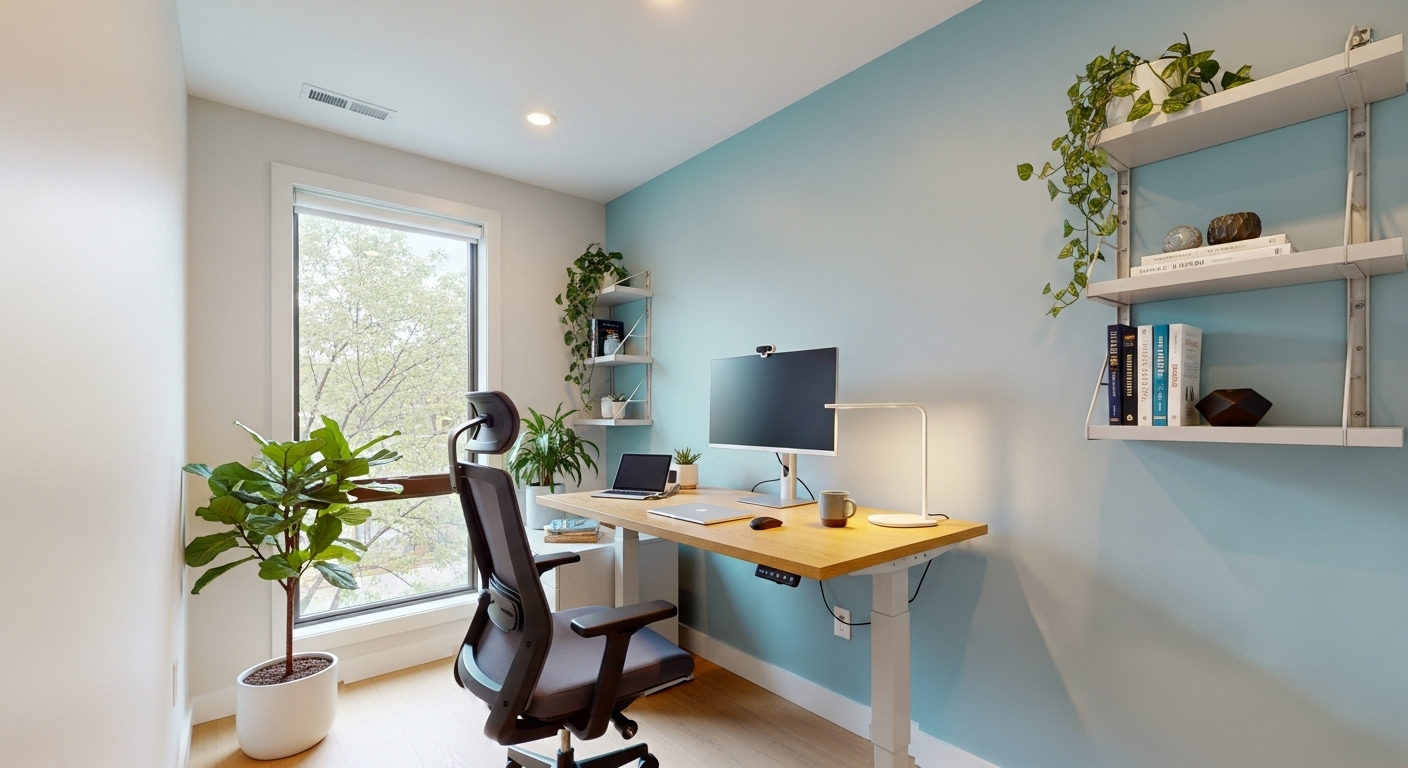The traditional commute is gone, but the need for a transition between our professional and personal selves has never been greater. For millions of professionals, the line between the living room and the boardroom has dissolved, replaced by an always-on culture that threatens the very flexibility remote work promised. This erosion of boundaries is a leading cause of digital exhaustion and burnout, a challenge that requires a new solution: the ‘digital commute.’ This isn’t a journey through traffic, but a conscious, structured transition that allows you to mentally and emotionally clock in and out. It’s a series of rituals and practices designed to build the walls that physical offices once provided for free. In this article, we’ll explore how to engineer your own digital commute, from crafting powerful start-of-day rituals to mastering the art of the ‘sunset shutdown.’ We will provide actionable strategies to manage digital noise, design a workspace that triggers focus, and reclaim your personal time for genuine rest and recharge, ensuring your remote career is not just productive, but truly sustainable.
Redefining the Boundary: From Physical Separation to Mental Transition
The daily commute once served a crucial psychological purpose. It was a liminal space, a buffer zone between the demands of the office and the comforts of home. This forced transition allowed for mental decompression, a gradual shifting of roles from employee to parent, partner, or individual. With the rise of remote work, this built-in boundary has vanished. The result, for many, is a state of perpetual work-readiness where the laptop’s glow is the first and last light they see. Studies consistently show that remote workers struggle more with unplugging than their office-based counterparts, leading to higher rates of stress and burnout. The challenge, therefore, is to consciously recreate this separation without a physical journey. This means shifting our focus from geographic distance to psychological demarcation. The goal is to establish clear mental markers that signal the start and end of the workday. Without these cues, the brain remains in a state of low-grade-alert, always anticipating the next email or notification. Building a mental boundary is an active process. It requires acknowledging that your workspace is now a state of mind as much as a physical location. By intentionally designing triggers and routines, you can train your brain to associate certain actions with focus and others with relaxation, effectively building a firewall against the ‘always-on’ creep and preserving your mental energy for the long term.
The Sunrise Ritual: Engineering Your Ideal Workday Kickstart
How you begin your day sets the tone for everything that follows. Rolling out of bed and immediately opening your laptop to a flood of emails is the remote work equivalent of being jolted awake by a fire alarm. It’s chaotic, reactive, and puts you on the defensive from the very first minute. A ‘sunrise ritual,’ the first leg of your digital commute, is the antidote. This is a deliberate, consistent pre-work routine designed to prime your mind for focus and intentionality. It’s not about adding more tasks to your morning, but about creating a calm, preparatory space before engaging with work. This ritual should be personal and non-negotiable. For some, it might be a 20-minute walk outside without a phone, allowing the mind to wander and wake up naturally. For others, it could be ten minutes of meditation or stretching, followed by brewing a cup of tea and reading a chapter of a non-work-related book. A highly effective strategy is to dedicate a 15-minute ‘planning phase’ where you review your priorities for the day on paper, away from the screen. This allows you to approach your inbox with a clear plan of action, rather than letting it dictate your schedule. The key is consistency. By performing the same sequence of actions each morning, you create a powerful Pavlovian response, signaling to your brain that it’s time to transition into a productive, focused state. This deliberate start prevents the blending of sleep and work, establishing a clear and positive beginning to your professional day.
The Sunset Shutdown: Mastering the Art of Logging Off
Just as crucial as a morning ritual is a ‘sunset shutdown’—a definitive routine that marks the conclusion of your workday. One of the biggest pitfalls of remote work is the ‘one last thing’ syndrome, where the day slowly bleeds into the evening, hour by hour. A shutdown ritual actively combats this by creating a hard stop. It’s the second, and perhaps most important, leg of your digital commute, signaling unequivocally to yourself and others that your workday is complete. This concept, popularized by author Cal Newport, involves a series of steps to ensure a clean break. First, conduct a quick review of your day. Acknowledge what you’ve accomplished to combat the feeling that you were busy but unproductive. Next, create a rough plan for tomorrow. This act of externalizing your pending tasks onto a list frees your mind from having to hold onto them overnight, reducing evening anxiety. Then comes the most critical part: the physical and digital shutdown. Close every single work-related tab, application, and file. Change your status on communication platforms to ‘away’ or ‘offline.’ Finally, perform a concluding physical action. This could be tidying your desk, watering a plant, or literally putting your work laptop into a drawer, out of sight. Some professionals even find it helpful to say a phrase aloud, like ‘shutdown complete.’ This multi-sensory process creates a powerful psychological cue that work is over, allowing your brain to fully disengage and transition into personal time without the lingering tether of unfinished business.
Managing Digital Proximity: Taming Notifications and Asynchronous Communication
In a physical office, boundaries are visible. A closed door or headphones signal a need for focus. In a remote setting, we are all digitally adjacent at all times, and the constant barrage of notifications is the primary wrecker of boundaries and deep work. Effectively managing this ‘digital proximity’ is essential for a sustainable remote life. The default settings on our devices and apps are designed for maximum engagement, not maximum well-being. The first step is to conduct a notification audit. Ruthlessly disable all non-essential alerts on your phone and computer. For communication platforms like Slack or Teams, customize your settings to differentiate between urgent pings (direct mentions) and general channel chatter. A powerful strategy is to embrace ‘notification batching’—checking your email and messages at specific, predetermined times (e.g., 10 AM, 1 PM, 4 PM) rather than reacting to each one as it arrives. This puts you in control of your attention. Furthermore, championing asynchronous communication within your team is transformative.
As one report by the remote-first company Doist states, “Async communication gives employees the autonomy to get their work done on a schedule that works best for them.”
This means normalizing the idea that an immediate response is not always required. Encourage detailed, thoughtful messages that don’t necessitate a real-time back-and-forth. This not only fosters deeper thinking but also respects colleagues’ focus time and different time zones, creating a calmer, more productive digital environment for everyone.
Designing Your Zone: Your Workspace as a Psychological Trigger
Your physical environment has a profound impact on your mental state. When working remotely, your workspace becomes a powerful psychological trigger that can either enhance focus or perpetuate distraction. The goal is to create a space that your brain exclusively associates with work. This doesn’t require a separate home office; even a small, dedicated corner of a room can be effective if its boundary is respected. The principle is ‘ monofunctionalism’—the space has one job. Avoid working from your bed or the sofa where you relax, as this blurs the lines and can interfere with both your productivity and your ability to rest. Invest in making your designated workspace comfortable and ergonomic, but more importantly, make it distinct. Use a specific lamp that you only turn on during work hours. Place a small plant on the desk that acts as your ‘work companion.’ When the workday is over, the environment must change. This is a crucial part of your sunset shutdown. If you work at the dining table, pack your laptop, notepad, and any work-related items into a box or bag and store them out of sight. If you have a dedicated desk, turn off the work lamp and tidy the surface. This simple act of ‘clearing the stage’ physically removes the cues for work, signaling to your brain that the role of ’employee’ is over for the day and it’s safe to transition into a state of relaxation. This environmental control is a cornerstone of a successful digital commute.
Protecting Your Recharge: Scheduling Personal Time and Deep Play
Successfully ending the workday is only half the battle. The other half is ensuring the time you’ve reclaimed is genuinely restorative. In the absence of the clear structures of office life, personal time can become a form of ’empty time,’ filled with passive activities like aimless scrolling that fail to truly recharge your mental and emotional batteries. To build a sustainable remote career, you must be as intentional about your leisure as you are about your work. This means actively scheduling and protecting time for ‘deep play’—hobbies and activities that are engaging, challenging, and provide a sense of accomplishment outside of your professional life. Treat these activities with the same importance as a client meeting. Block out time in your calendar for a gym session, a creative writing hour, a long walk, or a social call with friends. By putting it on the calendar, you are giving it weight and committing to it. This practice is vital for preventing burnout, as it ensures you are refilling your cognitive and creative wells. It also helps build a robust identity outside of your job title. When your entire sense of achievement is tied to your work, the pressure is immense. Cultivating skills and joy in other areas of your life provides balance, perspective, and resilience, making you not only a happier person but ultimately a more creative and effective professional.
Conclusion
The transition to remote work has offered unprecedented freedom, but it has also dismantled the fundamental structures that once protected our personal time. The ‘digital commute’ is the framework for rebuilding those structures in a way that fits our modern professional lives. It’s a conscious, daily practice of creating intentional beginnings and definitive endings. By engineering a sunrise ritual, you prime yourself for a day of focused, proactive work. By mastering the sunset shutdown, you draw a clear line that allows for genuine mental disengagement. This is reinforced by taming the constant stream of digital notifications, designing a workspace that acts as a psychological trigger for focus, and, most importantly, being fiercely protective of your recharge time. These strategies are not about rigid rules but about creating a personal rhythm that serves you. They are the tools you need to move beyond simply surviving remote work to truly thriving in it. The ultimate goal is to harness the autonomy of working from anywhere to build a more integrated, fulfilling, and sustainable life, where professional achievement and personal well-being don’t just coexist—they enrich one another.





